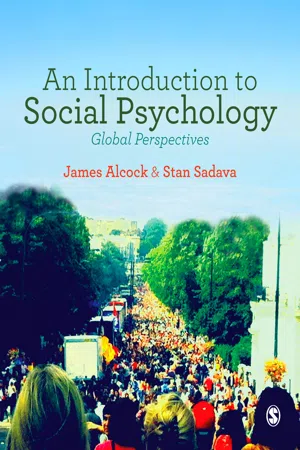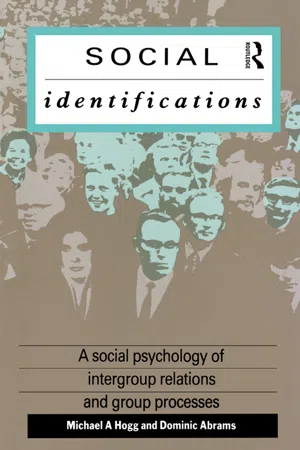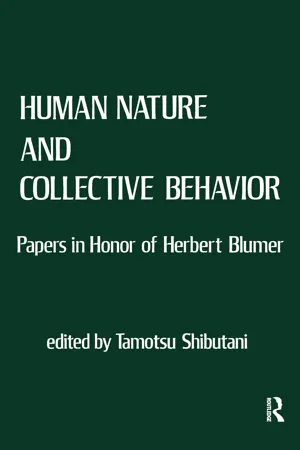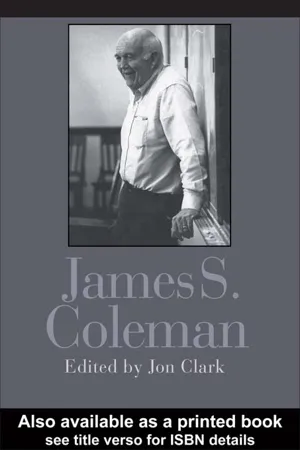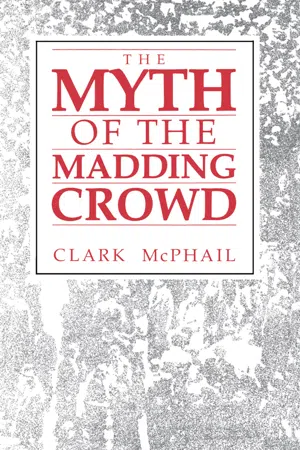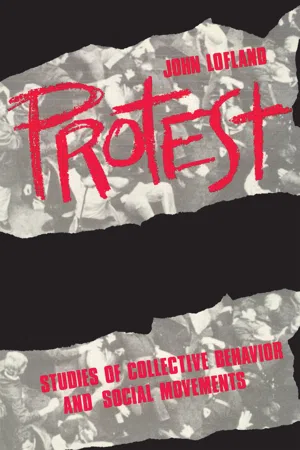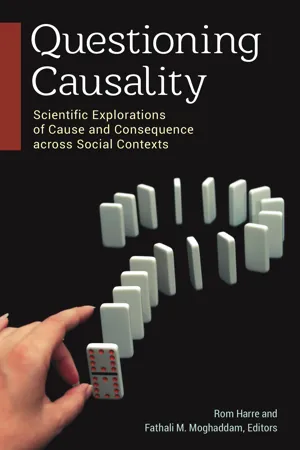Psychology
Collective Behaviour
Collective behavior refers to the spontaneous and unstructured actions of a group of people in response to a particular situation. It involves behaviors such as riots, panics, and fads, which are often driven by emotions and lack clear leadership or organization. This phenomenon is studied to understand how individuals behave within a group and the factors that influence their actions.
Written by Perlego with AI-assistance
Related key terms
Related key terms
1 of 4
Related key terms
1 of 3
10 Key excerpts on "Collective Behaviour"
- eBook - ePub
An Introduction to Social Psychology
Global Perspectives
- James Alcock, Stan Sadava(Authors)
- 2014(Publication Date)
- SAGE Publications Ltd(Publisher)
The Arab Spring: Social media such as Twitter, YouTube and Facebook have frequently been credited with spreading the flames of revolution during the Arab Spring – indeed some have even referred to the uprisings as the ‘Facebook Revolution’ (Howard et al., 2011; Moss, 2012). Indeed, social media appear to have played a crucial role. Despite years of the public dissatisfaction with their governments, it was not until emotionally distressing pictures and stories were circulated through social media that people became enraged and those revolutions were born. Communication is a key component in any uprising, both in terms of inflaming passions and organizing a collective response, and social media have the advantage that as long as they are in operation, authorities lose their ability to control the flow of information, and thus can no longer substitute propaganda for truth. Women in particular were front and centre in the Arab uprisings, emboldened by encouragement and coordination through social media to fight for social change (Radsch, 2012).What is Collective Behaviour?
The examples above illustrate three defining characteristics of Collective Behaviour (Milgram & Toch, 1969). It is:- A relatively rare phenomenon that emerges spontaneously in a collectivity of people (e.g., a crowd or an entire society).
- Unplanned and relatively unorganized, initially without a formal governance and without the specific rules and norms that characterize formal groups.
- Energized by inter-stimulation among the participants – that is, individuals are influenced by the actions of others, and their reactions in turn influence the very people who have affected them.
Sometimes Collective Behaviour involves an intensification of anticipated reactions. For example, while teenagers may go to a rock concert expecting to be excited, interaction among audience members can create a collective experience that is much more powerful than anticipated and more intense than anything the individual would experience alone or in a small group. Inter-stimulation is reinforcing to some extent; otherwise the behaviour would quickly die out. If one person throws a rock through a window and is admonished by others, it is unlikely that this behaviour will spread. However, if some in the crowd cheer, then a second person may also break a window, and a third, and the behaviour may spread quickly throughout the throng.The study of Collective Behaviour is an important part of social psychology, not only in its own right, but also because there is hardly any aspect of social behaviour that does not occasionally find expression, sometimes even extreme expression, through some type of collective episode (Milgram & Toch, 1969). For example, prejudice is sometimes expressed through mob behaviour, which can involve aggression. Both attitude change and impression management are evident in fads and fashions; people adopt behaviours that would earlier have seemed frivolous (‘high fives’) or even repugnant (e.g. body piercing). - eBook - ePub
- Neil J. Smelser(Author)
- 2013(Publication Date)
- Routledge(Publisher)
Chapter I Analyzing Collective Behavior IntroductionThe Problem. In all civilizations men have thrown themselves into episodes of dramatic behavior, such as the craze, the riot, and the revolution. Often we react emotionally to these episodes. We stand, for instance, amused by the foibles of the craze, aghast at the cruelties of the riot, and inspired by the fervor of the revolution.The nature of these episodes has long excited the curiosity of speculative thinkers. In recent times this curiosity has evolved into a loosely defined field of sociology and social psychology known as collective behavior. Even though many thinkers in this field attempt to be objective, they frequently describe collective episodes as if they were the work of mysterious forces. Crowds, for instance, are “fickle,” “irrational,” or “spontaneous,” and their behavior is “unanticipated” or “surprising.” For all their graphic quality, such terms are unsatisfactory. They imply that collective behavior flows from sources beyond empirical explanation. The language of the field, in short, shrouds its very subject in indeterminacy.Our aim in this study is to reduce this residue of indeterminacy which lingers in explanations of collective outbursts. Although wild rumors, crazes, panics, riots, and revolutions are surprising, they occur with regularity. They cluster in time; they cluster in certain cultural areas; they occur with greater frequency among certain social groupings—the unemployed, the recent migrant, the adolescent. This skewing in time and in social space invites explanation: Why do collective episodes occur where they do, when they do, and in the ways they do?In this introductory chapter we shall merely raise some questions posed by such an inquiry. What is collective behavior? What are its types? How is it to be distinguished from related behavior such as ceremonials? What are the determinants of collective behavior? Are the determinants related to one another in any systematic way? What can a sociological approach contribute to an understanding of collective behavior? Having raised the questions, we shall devote the remainder of the volume to searching for their answers. - eBook - ePub
Collective Behavior and Public Opinion
Rapid Shifts in Opinion and Communication
- Jaap van Ginneken(Author)
- 2003(Publication Date)
- Routledge(Publisher)
Social Problems journal of the famous Society for the Study of Social Problems. It was titled, “Collective Behavior—An Examination of Some Stereotypes.” It became a kind of manifesto. In it, he identified ten widespread stereotypes about collective behavior: spontaneity, lower class participation, suggestibility, emotionality, irrationality, mental disturbance, lack of self-control, antisocial behavior, destructiveness—but on occasion, also creativity. He proceeded to show that the arguments for this were weak, contradictory, and not well established. Couch and others therefore called upon experts to finally let go of the “armchair theories,” and to do more empirical research on the everyday realities of collective behavior.This further contributed to a wave of dozens of empirical studies, published over the next 20 years, and to the emergence of a family of theories that has been brought together under the label of the convergence approach and/or the social behavioral and interactionist (SBI) approach. The most important theoretical and practical work was done throughout the 1970s and 1980s by Clark McPhail (1991), along with colleagues such as David Miller (1985). First of all, they decided not to focus exclusively on (psychological) crowds, because the existing terminology was tainted, vague, and abstract. Rather, they chose to focus on gatherings, which formed a more neutral, well-defined, and concrete category. Often these were simple meetings or parades. Supposedly, “typical” collective behavior might emerge, but did not need to.In such meetings, a number of people (two or more) would gather at a specific time, in a specific place. These events had a life cycle of their own, consisting of three phases: coming together, being together, and leaving. A number of typical situations were identified for each phase. Leaving, for instance, could be a routine affair or an emergency evacuation. The latter could be a reaction to a threat (an attack or a disaster, for instance), or to uniformed intervention (e.g., military or police), and so on. Each of these situations had their own inherent logic. - eBook - ePub
Social Identifications
A Social Psychology of Intergroup Relations and Group Processes
- Dominic Abrams, Michael A. Hogg(Authors)
- 2006(Publication Date)
- Routledge(Publisher)
This powerfully evocative and classic description, from the pen of one of the greatest of all literary commentators on the crowd, not only encompasses the entire range of Collective Behaviour, but describes the same historical events which early crowd theorists (e.g. Gustav Le Bon) employed as their prototype. Zola’s style of description set the mould for what many social psychologists, even to the present day, consider to be the problematic of Collective Behaviour. The extract illustrates many of the themes to be discussed in this chapter: the uniformity and solidarity of the crowd; its unanimity and the poignancy of its symbols; the animal nature of crowd action; its madness, as well as its logic and its wider intergroup context (poverty, oppression, etc.).Introduction
Demonstrations, sit-ins, strikes, and riots are all examples of Collective Behaviour. They come about when people collaborate in order to achieve some objective. That collaboration may not be planned or well organized, but it is goal-directed and often involves large numbers of people. In Chapters 5 and 6 we examined the way that groups form, and the consequences of being in a group for individual behaviour. This chapter takes us on a step, to see how large collections of individuals who are together at the same place at the same time manage to behave in unison as groups.We explore two themes in the social psychology of Collective Behaviour. The first, which stems from the ideas of Gustave Le Bon ([1896]1908) assumes that the behaviour of crowds can be explained by extrapolating from processes which are deeply rooted and exist within its individual members (albeit at an unconscious level). We have already described (in Ch. 3 ) Berkowitz’s and Gurr’s extension of frustration-aggression theory to the level of Collective Behaviour. These theorists share with Le Bon and others a belief that any differences which exist between collective and individual behaviour can be explained as resulting from the physical - eBook - ePub
Human Nature and Collective Behavior
Papers in Honor of Herbert Blumer
- Tamotsu Shibutani(Author)
- 2023(Publication Date)
- Routledge(Publisher)
He cannot simply deduce the observed behavior from prior knowledge of the structured aspects of the situation. As Kurt and Gladys Lang have so rightly emphasized, the study of collective behavior is the study of “collective dynamics” and “collective processes.” 2 But the field of collective behavior deals with many different kinds of phenomena. Crowds, crazes, panics, and social movements are all examples of collective behavior, and as such they have much in common, not the least of which is their deviation from the established forms of social behavior. But they are also different from each other, and one major dimension of differences is the degree to which they lead to an alteration of those orderly and structured features of society to which the sociologist usually directs his attention. The successful social movement brings about a change in the society in which it occurs. Many crowds lead to a response from the agencies of control which has lasting effects, such as new legislation or administrative reorganization. One concern of the student of collective behavior, therefore, is to chart the process of structural change which evolves from these phenomena. 2 Kurt and Gladys Lang, Collective Dynamics (New York: Thomas Y. Crowell Co., 1961). A more fundamental concern of the student of collective behavior, however, is to examine the common features of all of these various phenomena. The very fact that they are all collective actions which involve deviations from the established forms of social behavior indicates that some new basis of concerted action must be evolved. Whatever the degree of lasting impact on the society in which they occur, therefore, all of these forms of collective behavior involve the development of new collective interpretations of a set of experiences - eBook - ePub
- Dr Jon Clark, Jon Clark(Authors)
- 2005(Publication Date)
- Routledge(Publisher)
11Methodological Individualism andCollective Behaviour
Benjamin ZablockiIt’s amazing to me that the problem of accounting for Collective Behaviour has still not been solved. The phenomenon of elementary Collective Behaviour (riots, panics, expressive crowds, hostile mobs, fads, religious frenzies, etc.) has been kicking around the fringes of sociological theory for a long time. It has always seemed to be one of the potentially easier problems to solve even by the exacting and convoluted standards of the social sciences where every solution seems always to be up for rhetorical grabs. It looked like sociology was on the brink of fully explaining the phenomenon thirty years ago when Roger Brown (1965) threw a startling but brilliant light upon the subject by approaching it for the first time from an internally consistent perspective of rational action theory and methodological individualism. Brown’s approach, though necessarily sketchy, provided a theoretical framework within which a concerted program of research could be launched with the aim of solving the problem of Collective Behaviour. But then, as so often happens in our discipline, the problem was half solved and we lost interest in it and went on to other things.A review of James Coleman’s curriculum vitae shows that Coleman has been interested in the problem of Collective Behaviour from the very beginning of his career as a sociologist. Some of his very earliest publications (Coleman, 1957; Coleman and McPhee, 1958; Coleman, 1961c) represent early attempts to understand aspects of crowd behaviour and the closely related phenomenon of the diffusion of innovations. Although Collective Behaviour phenomena have never been at the forefront of Coleman’s research agenda, it is fair to say that the problem has been on his back burner consistently throughout the years. The problem of Collective Behaviour lacks direct policy significance, except perhaps in ‘very interesting times’ and is thus important primarily for its potential contribution to basic theory rather than to applied social research. As Coleman has taken quite seriously his own admonition that sociological research be policy relevant, other more urgent issues have always seemed to direct his attention away from making a concerted attack on the problem of Collective Behaviour. For example, Coleman gives only scant attention to Collective Behaviour in his The Mathematics of Collective Action - eBook - ePub
- Clark McPhail(Author)
- 2017(Publication Date)
- Routledge(Publisher)
McAdam (1982) plotted trends of demonstration gatherings, events, and campaigns in the U.S. civil-rights movement between 1960 and 1965. He suggests that “peaks in movement activity correspond to the introduction of new protest techniques” (1982:165) and, as I noted earlier, represent waves of tactical innovation that spread across states, regions, or nations in a short period of time. Tactical innovations in various forms of collective protest expanded to campaigns and waves: the sit-in campaign of 1960; the jail-in campaign in the winter and the freedom ride campaign in the summer of 1961; the boycotts, rallies, marches, and pickets in the communities of Albany, Georgia, in 1962, Birmingham, Alabama, in 1963, Selma, Alabama, in 1965, and, the voter registration campaign in Mississippi in 1964. These are trends of campaigns, events, gatherings, and of sequences of collective behavior.Summary and DiscussionThe concepts of crowd and collective behavior have been used interchangeably in the sociological literature for more than a half-century. Neither has proven fruitful. The traditional concept of crowd has been useless because it connoted too much. Traditional conceptions of collective behavior have been equally useless because they denoted too little, more frequently implying an explanatory perspective than specifying, describing, and classifying the social phenomena to be explained.The common denominator in most dictionary definitions of crowd is a compact gathering or collection of people. Unfortunately, the additional suggestion or connotation ordinarily conveyed is one of the homogeneity of that collection of people or the unanimity of their behavior, or both. Neither popular nor scholarly usage has allowed for, let alone recognized, variation in behavior across the collection of people at any one point in time, let alone variation across successive points in time. In short, the concept of crowd has prevented recognition of alternation between and variation among collections of people behaving individually and collectively. In failing to recognize this variation and alternation, students of the crowd (and of collective behavior) proceeded to develop explanations for unanimous and homogeneous behaviors, i.e., for phenomena that rarely occur and are short-lived if and when they do.People do behave collectively; but what they do together varies greatly in complexity, in duration, and in the proportion of the gathering that actually participates. In one sense, recognition of this variation would appear to make more difficult the task of the student of crowds and collective behavior. But, in fact, the task is made more manageable and therefore simpler. Attempts to describe and explain the crowd have been an impossibly large task to date. By breaking that task into smaller components, the problem is reduced to several tasks, each of more realistic proportions. - eBook - ePub
Protest
Studies of Collective Behaviour and Social Movements
- John Lofland(Author)
- 2017(Publication Date)
- Routledge(Publisher)
Last, there is the question of the use of dominant emotion as a means of classifying forms of collective behavior. Some people would observe that the most recent movement in the field is explicitly away from concern with emotion because such a stress asserts or implies unusual or peculiar psychic states or mechanisms such as “contagion,” “circular reaction” (Blumer 1969b:70-71; Turner 1964), cognitive “short-circuits,” and “compressed” ways of acting (Smelser 1963:71). Imputations of “crudeness, excess, and eccentricity” arise along with characterizations of collective behavior as “the action of the impatient” (Smelser 1963:72).1 have no quarrel with those who reject such images of collective behavior and fear that they are a consequence of a stress on emotions. My concern is that stress on the cognitive (and behavioral) commits the opposite error, that of reducing the field to exercises in cognitive theory or, even more extremely, to a species of behaviorism in which the study of collective behavior is merely the study of human coordination (e.g. Couch 1970; McPhail and Wohlstein 1983). At bottom, it is probably impossible to decide rationally which course to take, because the longer-term consequences of the cognitive, affective, or behavioral stresses are impossible to assess beforehand and the fruitfulness of each changes as each emergently takes account of the others. In the end, effort to integrate all three must be made.Organizational Form. Crosscutting each of the dominant emotions are questions of the organizational form in which collective behavior arises. Historically, the field stressed distinctions between the crowd, the mass, the public, and the social movement. Over recent decades the latter two have come increasingly to be treated as separate specialties, especially in the case of the public and public opinion. (Virtually alone, Turner and Killian’s [1972] text continues to treat public opinion.) It is indicative that the American Sociological Association-sponsored volume in which this analysis originally appeared provided each its own chapter.In many recent treatments, even the distinction between the crowd and the mass has been deemphasized in favor of addressing collective behavior per se (e.g. Perry and Pugh 1978). Neil Smelser’s (1963) grand synthesis appears to have started this trend by defining its main dependent variables—the panic, craze, and hostile outburst—in a way that rendered crowd and mass forms irrelevant. - eBook - ePub
- Sara Breinlinger, Caroline Kelly(Authors)
- 2014(Publication Date)
- Taylor & Francis(Publisher)
Chapter 2 Social Psychological Approaches to Collective ActionDOI: 10.4324/9781315810133-2Theoretical approaches to collective action are many and varied. Part of the reason for the heterogeneity derives from the different definitions of collective action which have been adopted. For many social scientists, the term collective action encompasses an incredibly broad range of empirical phenomena - 'from raising an army to raising a barn' (Marwell and Oliver, 1993 : 1) - whose common elements, these authors suggest, are mutual interests and the possibility of benefits from coordinated action. For those interested specifically in a political context, the term refers to a type of political action which consists principally of 'working through organised or informal groups ... to raise an issue' (Parry, Moyser and Day, 1992 : 52).In the present research, we adopt a more social psychological definition of collective action: 'A group member engages in collective action anytime that he or she is acting as a representative of the group and the action is directed at improving the conditions of the entire group' (Wright, Taylor and Moghaddam, 1990 : 995). Even with this very specific definition, there are a number of different social psychological theories on which we can draw in trying to understand individual participation in collective action.The explanations which have been put forward to address the issue of individual participation may be divided into two types according to the level of analysis adopted. First, there are those explanations which focus on an individual level. These theories describe either individual personality characteristics or individual decision-making processes which lead particular people to get involved in action. By contrast are those theories pitched at a group level of analysis which describe features of the intergroup context and perceptions of that context which promote or inhibit participation in collective action. - eBook - ePub
Questioning Causality
Scientific Explorations of Cause and Consequence across Social Contexts
- Rom Harré, Fathali M. Moghaddam, Rom Harré, Fathali M. Moghaddam, Rom Harré, Fathali M. Moghaddam(Authors)
- 2016(Publication Date)
- Praeger(Publisher)
To many psychologists as well as laypeople, it seems self-evident that only individuals have agency, and that is why we study collective action by asking individuals about their intentions to act. However, we would argue that a moment’s thought will call into question the tight lens on individual members: groups act collectively; groups revolt, riot, attack, liberate, repress, and strategize. Just as free will for the individual has a levels-of-analysis issue, with the possibility of internal causation (e.g., thoughts may sometimes lead to emotions; emotions may bias thoughts; and external factors may generate both), so too groups have levels-of-analysis issues that involve but transcend individuals’ agency. That is, groups influence individuals, reactively and proactively. The interaction of two individuals is more than the sum of their individuality: they form a dynamic system that calls out emergent qualities both complementarily (e.g., speaker/listener turn-taking) and communally (e.g., coupledom). So too, groups are more than individual group members: they structure individuals relationally (e.g., leader-follower) and define them jointly (e.g., with group identities and norms). These processes may precede individuals’ decisions and shape them by social influence, as well as evoking individuals’ qualities of resistance, leadership, innovation, and so on (e.g., Louis, 2009).This dynamic of emergent collective agency is rarely explicated or empirically addressed in psychology (cf. e.g., Haslam, Reicher, & Platow, 2013). However, in political science, Oliver (e.g., 1980, 1993) has distinguished models of collective action based on groups as actors from other models. Collective action, as the aggregated outcome of individuals’ choices, are the outcome of the dynamics of individuals’ choices where not all group members have the same interest. We hope that this complexity will increasingly be acknowledged in social psychology, particularly as new statistical models such as multilevel modeling and hierarchical linear modeling facilitate explicit analyses of the impact of individuals on group-level decisions and vice versa.
Index pages curate the most relevant extracts from our library of academic textbooks. They’ve been created using an in-house natural language model (NLM), each adding context and meaning to key research topics.
Explore more topic indexes
Explore more topic indexes
1 of 6
Explore more topic indexes
1 of 4
